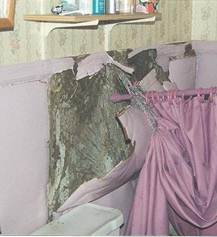Structural Issues Related to Mold, Mildew and other Fungi

When dealing with mold and mildew in buildings, moisture management is the most effective long term solution for prevention and control. There are fungicides available to control or prevent wood infesting fungi, but unless moisture reduction is part of a management plan their effectiveness will be reduced. Mold and other fungi may cause damage to a structure or adverse health effects such as allergies, asthma or infection. There are some mildews which pose little risk to the building or occupant but become visually unacceptable on a surface within the structure. It is important to determine whether moisture management alone is sufficient or if further mold cleaning is required.
Typically, structural mold issues can be resolved through moisture management and clean up or removal of infested materials. Moisture management techniques may include adding additional drainage to a foundation, installing a moisture barrier to a crawlspace, using a dehumidifier in a basement area or making roof repairs. Each of these steps will reduce the amount of water present in a home or building. Indoors, property owners also need to pay attention to the grout and caulking around tubs and sinks and watch for leaks in plumbing. While some moisture issues are very apparent other issues require the use of devices such as a moisture meter for diagnoses.
Businesses are required to obtain a Virginia Pesticide Business License and pesticide applicator certification from VDACS when pesticides are used to treat, prevent or control wood decay fungii that infest structures and cause wood rot (see Wood Rot resources below). VDACS does not currently require licensing or certification for the use of pesticides to treat for surface molds (i.e. Fusarium spp., Penicillium spp.). Any pesticide used to manage mold, mildew or similar organisms has to be registered for use with the Office of Pesticide Services.
EPA's Mold Course
The Environmental Protection Agency (EPA) has developed an online mold course for environmental and public health professionals which provides guidelines for mold prevention and mold remediation. While the course may supplement employee training, additional training may be necessary to obtain a license or applicator certificate from VDACS.
Introduction to Mold and Mold Remediation for Environmental and Public Health Professionals
To learn more about Wood Rot caused by wood decay fungi visit the following websites:
Fact Sheet on Powderpost Beetles and Wood Inhabiting Fungi (NC State)
Management of Wood-destroying Pests (Michigan State University) Chapter 7 deals with Wood-Damaging Fungi
For more information about molds and mildews visit the websites listed below:
Environmental Protection Agency
Mold Resources
A Brief Guide to Mold, Moisture and Your Home
Mold in Schools and Commercial Buildings
Should You Have the Air Ducts in Your Home Cleaned?
Centers for Disease Control
Mold Web Site
Virginia Department of Health
Mold Information
Virginia Cooperative Extension Resources
Mold Basics
Mold Remediation
Mold Prevention
National Pesticide Information Center (NPIC)
Controlling Mold with Antimicrobial Pesticides